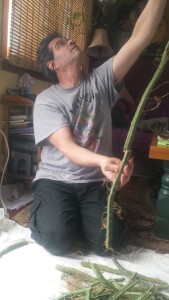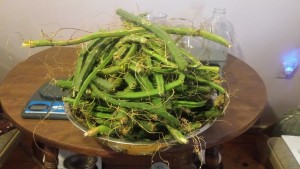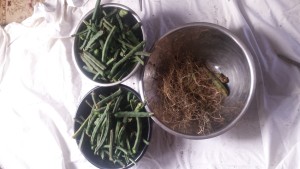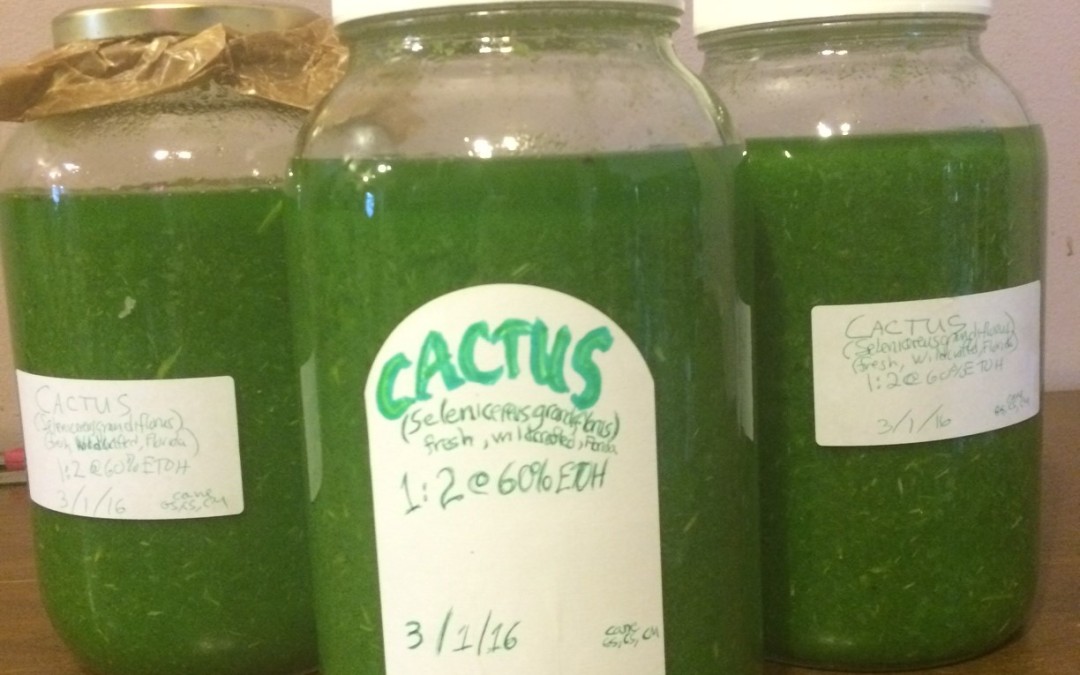Processing night-blooming cereus cactus into tincture medicine
What would a blog series on night-blooming cactus (Selenicereus grandiflorus) be if I left you hanging and neglected to talk about the last part of the process? That is, turning raw cactus into a potent, long-lasting tincture preparation. Here I would like to invite you into the intricacies and realities of an herbalist’s life and practice as I talk in more detail about what we did, and where we are at, in relation to making cactus tincture for the Clearpath Herbal’s apothecary.
After we returned from our road trip to Florida, I was met with the usual deluge of things piled up from being away for the better part of two weeks. Fortunately, members of the cactus family are resilient and naturally know how to survive when disconnected from a water supply. I took advantage of this and let them sit in a bag in a cool dark place while I attended to more time-sensitive matters.
 If you read the previous blog entries I wrote on the cactus wildcrafting expedition, I also said that I found another medicinal herb — Spanish Needles (Bidens pilosa), a potent broad-spectrum antimicrobial herb that is most potent when made fresh. And Bidens, being a typical herbaceous plant, is not as resilient and durable as cactus. For the entire trip back from Florida my number one priority was to keep the Bidens cool and fresh, and it took more space than anything else in our travel cooler. An herbalist always thinks of the medicine first. It would have really bummed me out if the plant we took the time to pick had gone bad before we ever had a chance to make medicine from it. When we arrived home, the Bidens was still very fresh, and turning it into an alcohol-tincture maceration was the most pressing priority.
If you read the previous blog entries I wrote on the cactus wildcrafting expedition, I also said that I found another medicinal herb — Spanish Needles (Bidens pilosa), a potent broad-spectrum antimicrobial herb that is most potent when made fresh. And Bidens, being a typical herbaceous plant, is not as resilient and durable as cactus. For the entire trip back from Florida my number one priority was to keep the Bidens cool and fresh, and it took more space than anything else in our travel cooler. An herbalist always thinks of the medicine first. It would have really bummed me out if the plant we took the time to pick had gone bad before we ever had a chance to make medicine from it. When we arrived home, the Bidens was still very fresh, and turning it into an alcohol-tincture maceration was the most pressing priority.
By the time I turned my attention to the cactus, another week had elapsed. Lo and behold, when we removed the cactus from its storage area, it appeared nearly as fresh as when I picked it many days earlier. Or so it seemed. . .
Water weight loss and night-blooming cereus cactus
Back in Florida I had weighed the fresh plant material soon after picking it. Its weight at that point was just over 23 pounds. When I re-weighed the bag at home, the weight had reduced to 13 pounds, which means that the plant material had lost a little more than 10 pounds of water weight. If you do the math, that amounts to 43.5% of the total original weight of the plant material.
 Now, typical water-weight percentage for cactus averages 90-95% of the plant’s total weight. That fact is pretty amazing in its own right. It means that cactus is virtually all water, and only 5-10% of a cactus’s weight is what makes it the unique being that it is, including all of its medicinal virtues. If 90-95% of fresh cactus is actually water, then of the 23 pounds of fresh cactus that I started with, between 20.7 and 21.8 pounds of the weight is actually water, and only 1.15-2.3 pounds is solid cactus material.
Now, typical water-weight percentage for cactus averages 90-95% of the plant’s total weight. That fact is pretty amazing in its own right. It means that cactus is virtually all water, and only 5-10% of a cactus’s weight is what makes it the unique being that it is, including all of its medicinal virtues. If 90-95% of fresh cactus is actually water, then of the 23 pounds of fresh cactus that I started with, between 20.7 and 21.8 pounds of the weight is actually water, and only 1.15-2.3 pounds is solid cactus material.
So, in actuality, losing just over 10 pounds of water weight means that the plant material had lost almost 50% of its original water content. This might seem trivial and superfluous, but it does matter when it comes time to measure safe and accurately optimum amounts of alcohol and water to add to the cactus material, which in herbal technical jargon, is called the ‘marq’. By ‘safe’, I mean ensuring that enough alcohol is added to prevent spoilage by opportunistic bacteria and mold. General practice puts that number at 22-23% alcohol content. By ‘accurately optimum’, I mean to ensure that the best ratio of alcohol-to-water volume is achieved in order to maximize the medicinal potency of the finished preparation. This is a piece of cake when we begin working with bone-dry plant material. Once we have to take into account water that is inherently present in fresh plant material (as a general rule of thumb, most organic life forms on planet Earth are 70% and upward water weight), then things get trickier.
Preparing night-blooming cereus for cactus tincture making
Before anything else, a couple of assistants and I needed to garble the plant material. That means cleaning the plant so only the choicest material is kept for the medicine making process.
 Of the 13 pounds of plant material remaining, I decided to use 10 pounds for our apothecary needs. I also knew that I wanted to reserve some of the cactus for other herbalists and for propagation. The best plants for propagation are not necessarily the best for making medicine, and in the case of cactus, this played to our advantage. Why? Because the plants I picked that were least attractive for making medicine turned out to be best qualified for re-growing new roots and taking off as a new plant in a new location.
Of the 13 pounds of plant material remaining, I decided to use 10 pounds for our apothecary needs. I also knew that I wanted to reserve some of the cactus for other herbalists and for propagation. The best plants for propagation are not necessarily the best for making medicine, and in the case of cactus, this played to our advantage. Why? Because the plants I picked that were least attractive for making medicine turned out to be best qualified for re-growing new roots and taking off as a new plant in a new location.
A couple of discerning herbalists took me up on my offer for wildcrafting fresh cactus for them, so that they could make medicine for themselves. Several more herbalists as well as called to say that they were interested in the medicine, but that they would let me do the work and wait for the final product. So, I knew how much material I had to start with and what I wanted to do with it. I separated out the best plants for propagation, and that amounted to about one pound. That left two pounds of material for the other herbalists who wanted some for medicine.
Calculating the proper ratios for night blooming cereus cactus tincture
All this talk about weight and poundage! How does it translate to the actual maceration that ends up sitting in a jar for several weeks?
 First, you need to know what ratio of plant to menstruum to use. ‘Menstruum’ is the term herbalists use to describe the liquid portion — the solvent mixture — of the herbal preparation, which in the case of fresh cactus medicine means 95% alcohol (I use alcohol derived from organic sugar cane), water already present in plant, and perhaps more water added if need be.
First, you need to know what ratio of plant to menstruum to use. ‘Menstruum’ is the term herbalists use to describe the liquid portion — the solvent mixture — of the herbal preparation, which in the case of fresh cactus medicine means 95% alcohol (I use alcohol derived from organic sugar cane), water already present in plant, and perhaps more water added if need be.
Herbalists with kitchen-level technology aspire to make fresh tinctures at a ratio of 1:2, meaning 1 part plant material to 2 parts liquid menstruum. That is the ideal, but sometimes we have to settle for something less concentrated, like 1:2.25, 1:2.5, or 1:3, depending on the nature of the plant material.
Being that cactus is so succulent to begin with, it makes a very liquidy soupy menstruum, and so it’s easy to achieve an optimum 1:2 ratio. Less than optimum would mean that the top portion of the maceration (marq + menstruum) is too dry or above the level of the liquid mass. This diminishes medicinal potency and increases the chances of contamination. Absorbent raw plant materials like mullein leaf and dried mushrooms require higher volumes of menstruum, but succulent plant material like corn silk and cactus do not.
I know from my materia medica research that cactus medicine is best extracted at a concentration of 60% alcohol, so in shorthand, that looks like 1:2 @ 60% alcohol (the remaining 40% is water needed).
 Now I am getting close to measuring out actual amounts. From years of practice, I know that for most fresh plants, about 3-3.25 pounds of fresh material yields about a gallon of maceration mash. Once I press it a few weeks later, it will be less than a gallon, but not by a whole lot, especially when it comes to cactus.
Now I am getting close to measuring out actual amounts. From years of practice, I know that for most fresh plants, about 3-3.25 pounds of fresh material yields about a gallon of maceration mash. Once I press it a few weeks later, it will be less than a gallon, but not by a whole lot, especially when it comes to cactus.
Here is where simple math skills and a calculator come in handy. First, from here on in, I convert pounds to grams, and ounces to milliliters, because it is easier with the measuring tools I use. 1 pound = 454 grams, so 10 pounds of cactus is 10 X 454 = 4540 grams of cactus. At a 1:2 ratio, it means I am going to use twice that amount for my total volume of menstruum.
Now, I know all you savvy math and science people out there are frowning because I broke a cardinal rule by changing units, in this case from weight and grams to volume and milliliters. This is true, I cannot deny it, and it has always bothered me too. But this is how we herbalists do it, and it is something you will just have to live with.
So, back to it. If my total plant material is 4540, then at a 1:2 ratio, I need to add 9080 ml of liquid, 60% of which is to be alcohol, and 40% of which is to be water. At this point, the fact that we weighed the cactus in Florida and again before garbling becomes important, because we now know that the cactus I am about to make is actually only 50% weight by water due to water loss from storage. That means, of the 9080 ml of plant material now present, half, or 4540 ml, is already water.
But at 40% water content, calculations tell me I only need to add 3630 ml water. Uh oh! There is already too much water present in the plant material. This means that even if I do not add any water to the menstruum mix (which I will not), simply adding 60% of the alcohol required — 5720 ml of 95% organic cane alcohol — is not enough. I have to add more in order for it to truly be 60% alcohol. This doesn’t happen too often in the world of making fresh herbal extracts. Cactus is an exception to the rule. Once I compensate for the actual amount of water present in the cactus, in actuality I have to add closer to 6,800 ml alcohol.
 And this is what my assistants wound up doing. After cleaning/garbling the cactus — removing rootlets and inferior material — we blended the rest in short order. Cactus is super easy to blend. We ended up with almost three full gallons of maceration. We were awed by the vibrant electric green color of the blended cactus medicine! Six weeks from the time of making it, I will press it out. It will lose some of its luster, but its beneficial cardiovascular and nervous system (see previous blog entries where this is discussed) medicine will still be very potent, and for years to come.
And this is what my assistants wound up doing. After cleaning/garbling the cactus — removing rootlets and inferior material — we blended the rest in short order. Cactus is super easy to blend. We ended up with almost three full gallons of maceration. We were awed by the vibrant electric green color of the blended cactus medicine! Six weeks from the time of making it, I will press it out. It will lose some of its luster, but its beneficial cardiovascular and nervous system (see previous blog entries where this is discussed) medicine will still be very potent, and for years to come.
As for the discerning herbalists who wanted some of the cactus herb for their private apothecaries, they told me that they wanted enough to make about a quart of tincture. If three pounds make one gallon, then three-quarters of a pound makes about a quart. I sold each of them one pound at ten dollars a pound, and one of them traded me fresh goat cheese that she had just made from the farm she is watching for the winter. Florida cactus for New England goat cheese. I call that a fair and tasty trade!



I am impressed with your site it very helps us and useful I follow you always You giving such a good nice tips and suggestions thanks for sharing with us You made this site is awesome thank you all your thoughts
I am still getting used to this website email format, so just seeing this email now. Sorry about that, but thank you for the compliment.
Hi Chris!
I’m from western mass and a big fan of your classes and products. Currently I’m in the amazon and want to make a tincture of two medicinal succulents. The first is hoja de aire (there are many names)- it is an antifungal, antibiotic and fights free radicals, to name a few of the properties. People here mash the leaves and apply directly on the skin or they make a decoction or fresh juice with the leaves. I want to make something that will preserve and came across this blog when googling how to preserve cacti. CAn you give me some advice on how to prepare and bottle tinctures with this succulent? We have all the material at los yapas, the organization I am volunteering at. I can send you some finished product as well ; ). many thanks to you!
HI Patti,
When it comes to making tinctures and knowing how much and what concentration of alcohol to use, it is always good to know what major constituents are in the plant. I am figuring if the people are using it directly or as a decoction, then the constituents are water soluble. If that is the case, then you just need enough alcohol to preserve the final liquid so that it doesn’t go bad.
Cacti are so succulent, it is safe to assume that water accounts for 90-95% of its fresh weight. That’s a lot.
To make it safe from bacterial overgrowth, you want the tincture to be no lower than 25% alcohol. I would suggest weighing the amount of cactus you want to use, assume that 90% is water, and then do the necessary calculations to find out how much alcohol you are going to add. I would recommend using 95% alcohol, because the more concentrated it is, the less liquid you will have to add.
Roughly speaking, for every 110g of cactus, the water content will equal ~ 100g. When it comes to water, g = ml, so 100g = 100ml water. To make that into a 25% alcohol tincture using 95% alcohol, you will have to add 40-50 ml of 95% alcohol to every 110 g of cactus in order to play it safe. And then just chuck it all in a blender and liquify it.
Did I make that clearer or more confusing?
Great post, wondering what kindof alcohl you used?
95% ethanol derived from organically grown sugarcane
Thank you for your post. This helped me with a paper I wrote for my Herbology and Botany class. I am pleased to see this is possible and effective!